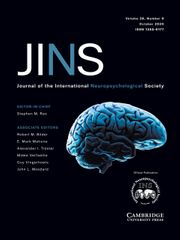Regular Research
Early Brain Injury and Adaptive Functioning in Middle Childhood: The Mediating Role of Pragmatic Language
-
- Published online by Cambridge University Press:
- 27 April 2020, pp. 835-850
-
- Article
- Export citation
An Incidental Learning Method to Improve Face-Name Memory in Older Adults With Amnestic Mild Cognitive Impairment
-
- Published online by Cambridge University Press:
- 22 May 2020, pp. 851-859
-
- Article
- Export citation
Cognitive Heterogeneity across Schizophrenia and Bipolar Disorder: A Cluster Analysis of Intellectual Trajectories
-
- Published online by Cambridge University Press:
- 19 May 2020, pp. 860-872
-
- Article
-
- You have access
- Open access
- HTML
- Export citation
The Assessment and Prediction of Prospective Memory after Stroke
-
- Published online by Cambridge University Press:
- 12 June 2020, pp. 873-882
-
- Article
-
- You have access
- Open access
- HTML
- Export citation
Frontal Behavior Syndromes in Idiopathic Normal Pressure Hydrocephalus as a Function of Alzheimer’s Disease Biomarker Status
-
- Published online by Cambridge University Press:
- 20 May 2020, pp. 883-893
-
- Article
- Export citation
REM Sleep Behavior Disorder in Parkinson’s Disease: Effects on Cognitive, Psychiatric, and Functional outcomes
-
- Published online by Cambridge University Press:
- 07 May 2020, pp. 894-905
-
- Article
- Export citation
Leukocyte Telomere Length Is Unrelated to Cognitive Performance Among Non-Demented and Demented Persons: An Examination of Long Life Family Study Participants
-
- Published online by Cambridge University Press:
- 28 April 2020, pp. 906-917
-
- Article
- Export citation
Differences in Discriminability and Response Bias on Rey Auditory Verbal Learning Test Delayed Recognition in Behavioral Variant Frontotemporal Dementia and Alzheimer’s Disease
-
- Published online by Cambridge University Press:
- 27 April 2020, pp. 918-926
-
- Article
-
- You have access
- Open access
- HTML
- Export citation
Brief Communication
Montreal Cognitive Assessment (MoCA) Performance and Domain-Specific Index Scores in Amnestic Versus Aphasic Dementia
-
- Published online by Cambridge University Press:
- 19 May 2020, pp. 927-931
-
- Article
- Export citation
Patterns of Cognitive Test Scores and Symptom Complaints in Persons with TBI Who Failed Performance Validity Testing
-
- Published online by Cambridge University Press:
- 27 May 2020, pp. 932-938
-
- Article
- Export citation
Front Cover (OFC, IFC) and matter
INS volume 26 issue 9 Cover and Front matter
-
- Published online by Cambridge University Press:
- 12 October 2020, pp. f1-f2
-
- Article
-
- You have access
- Export citation
Back Cover (OBC, IBC) and matter
INS volume 26 issue 9 Cover and Back matter
-
- Published online by Cambridge University Press:
- 12 October 2020, pp. b1-b2
-
- Article
-
- You have access
- Export citation

